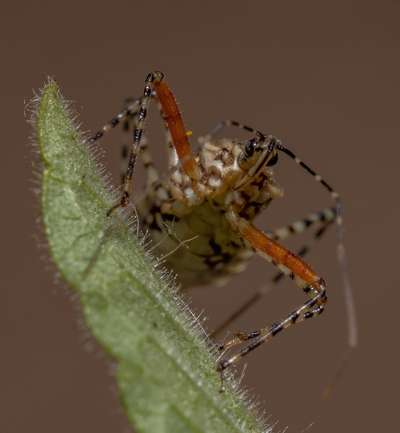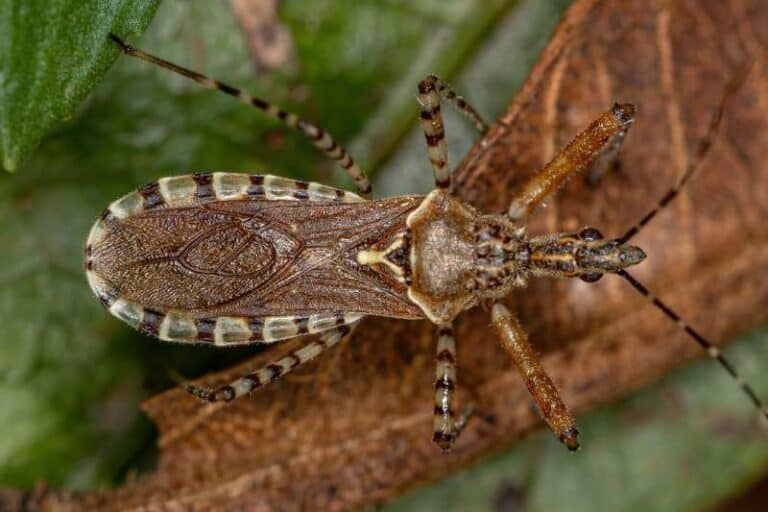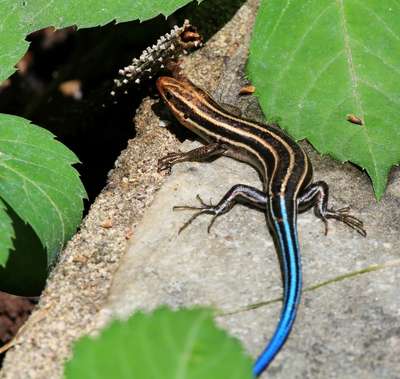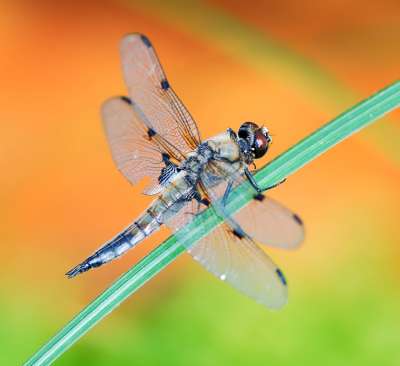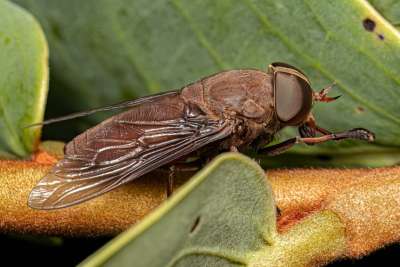Jumping spiders are found throughout North America. They are active during the day and are some of the most colorful spiders known. Also called “salticid spiders” or “salticids”, they belong to family Salticidae, which is the largest family in the spider order Araneae, and are famous for their excellent vision and ability to jump.
This post is the fourth in a series and focuses on the day to day lives of jumping spiders as carnivores; how they hunt and how they eat.
What do jumping spiders eat?
Jumping spiders are carnivores that actively hunt small insects and invertebrates. They will attack, and consume any creature they can overcome without sustaining injury. This includes flies, grasshoppers, crickets, earwigs, true bugs, beetles, butterflies, moths, and other spiders.
How do jumping spiders kill their prey?
Like all spiders, jumping spiders kill their prey by piercing their preys’ bodies with their fangs and injecting venom. The venom may either kill immediately or simply paralyze the victims, but begins digesting the prey from the inside out immediately, liquefying the prey’s inner structures.
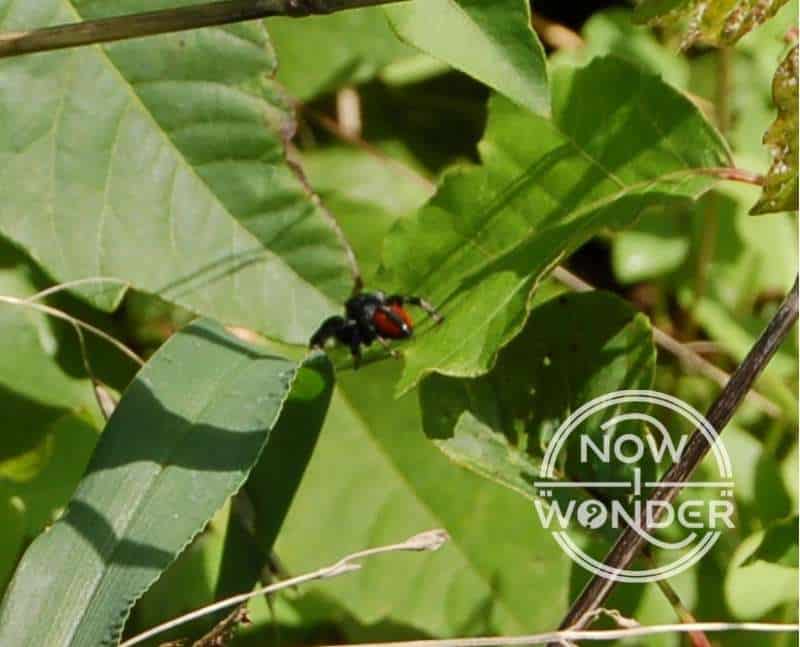
What makes jumping spiders special as predators?
Most spiders spin webs to entrap prey or ambush prey by rushing it on foot. But jumping spiders evolved a different approach; they spot, stalk, and jump to attack.
Orientation
Step one for a hunting jumping spider is to find food. Insects can crawl, jump, and/or fly so move around frequently and are alert for predators. Therefore jumping spiders must spot likely prospects quickly.
Salticids have excellent vision, thanks to two eyes that can resolve fine detail and can focus like a telephoto lens and six eyes that sense peripheral movement anywhere around their bodies. They use this finely honed sense to visually lock onto prey – or “orient” – from a distance. The spiders swivel to face objects of interest then continually reposition themselves to keep them within view of the acute vision of their large front eyes (Forster 1977).
For an in-depth discussion about jumping spiders’ visual acuity and orientation reflex, check out the second post in this series “Jumping Spiders #2 – A look at their incredible vision“.
Pursuit
Step two for a hunting jumping spider is to pursue the prey and get close enough to attack.
During pursuit, spiders walk, run, and creep up on their prey, always moving slightly faster than the prey to close the distance and get within range of an attack jump. But not all potential prey is pursued. Spiders seem to actively assess cost versus benefit of pursuing a given prey item and several factors are considered; prey movement, the spider’s hunger level, distance between the spider and the prey, and the spider’s evaluation of the prey.
Prey movement
Movement appears to be a major factor in whether a jumping spider pursues an insect. Jumping spiders may ignore motionless prey, even if it would otherwise be edible, and may cut off their pursuit if the targets go under cover where the spiders can’t see them anymore (Forster 1977).
Hunger
Jumping spiders are more apt to pursue prey when they haven’t eaten for a while and are hungry. Hunting uses a lot of energy and can be dangerous; conserving energy while avoiding unnecessary risk is a smart survival strategy. Spiders have low metabolic rates, especially compared to mammals like humans, so can thrive on intermittent meals.
Immediately after eating, a spider may not respond to potential prey in its near environment at all. After several hours to days have passed, the spider will have digested its meal and its hunger will rise. At this point, it will begin to show interest in likely prey by first orienting to the prey, then eventually moving into full pursuit and attack behaviors to secure its next meal (Gardner 1964).
Distance to prey
Thanks to their telescopic vision, salticid spiders can see extremely well across long distances. But they don’t expend energy pursuing every potential prey item they see. They use their excellent eyesight to decide if the effort is worth the payoff by gauging the distance and the obstacles between themselves and the prey.
Body size may impact the distance threshold that triggers pursuit. Second in-star Trite auricoma spiderlings with body lengths of 1.75 ± 0.15 mm only pursued prey within 35 mm (1.4 in) (Forster 1977), which is about 20 body lengths.
Assessment of potential prey
Many of the creatures that jumping spiders could attack have defenses of their own. These defenses can be direct or indirect or both.
Direct defenses are those that could help an individual insect escape an attack, such as the ability to bite or sting.
Indirect defenses are those that either discourage an attack from happening at all or punish the predator for attacking, such as manufacturing or storing toxins in its body tissues that sicken or kill.
Many times, these creatures attempt to avoid being attacked by being conspicuously colored, usually in high contrast color patterns of black, red, and orange. This evolved defense strategy is called “aposematic coloration”.
Sometimes aposematic coloration is a bluff – the creature is entirely edible but pretends to be toxic by assuming the same color pattern as those species that are truly dangerous to attack.
To learn about how some jumping spiders use mimicry to bluff potential predators of their own, check out my post “Jumping Spiders #5 – As Prey“.
Other times, though, there is “truth in advertising”.
For example, many parasitoid wasps are small enough to be considered likely prey by jumping spiders. Some species are non-toxic and edible; these have all black bodies. Other wasp species are toxic and thus would be dangerous for a jumping spider to eat. These sport black heads, orange thoraxes, and black abdomens.
This black-orange-black coloration warns predators that attacking them will be risky. Since jumping spiders use their eyes to identify potential prey and can see color well, they avoid attacking certain prey colored in this kind of bright pattern (Mora-Castro et al. 2021).
To learn about another creature that is toxic to predators and uses aposematic coloration to advertise it, check out my post “What do grasshoppers do? A day in their life” for information about the Eastern Lubber Grasshopper.
Detouring
Many salticid species live in complicated environments full of vegetation that may hide the prey from view during pursuit. Remarkably, a jumping spider can hold a target’s last known position in its brain and find a path to intercept, even when the spider can’t see it anymore – a very complicated task that required sophisticated working memory and goal planning.
This ability is called “detouring” and is most well known in vertebrates and creatures like octopuses (Wells 1970).
The distance over which a jumping spider can successfully detour varies by species, with some being able to intercept prey over long distances based only on the initial visual scan and other requiring re-orientation at points along the way. Jumping spider species also vary in how efficiently they choose their paths, with some finding shorter routes to targets than others (Aguilar-Arguello, Gerhard, and Nelson 2020).
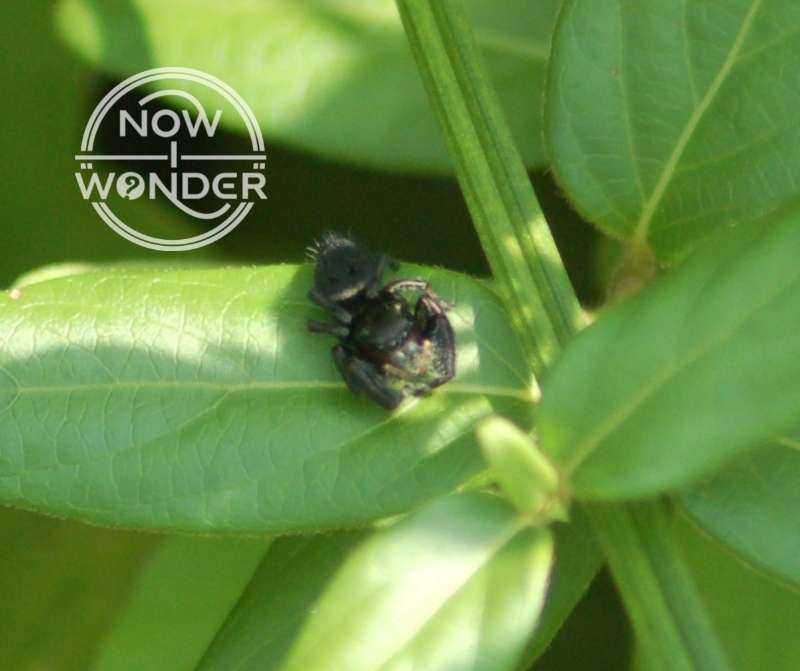
Attack and capture
Pursuit continues until the spider loses interest, retreats, or the prey escapes (i.e. flies off). Assuming all goes well and the spider remains unnoticed, it shifts to “capture” mode when it judges it is within attack distance.
Attack distance varies with different jumping spider species. In Trite auricoma spiders mentioned above, this distance is within approximately three body lengths (5 mm or less) (Forster 1977).
Jumping spiders are cautious, as predators tend to be. Carnivory is a dangerous business; attack, or “capture”, behaviors involve several steps, all of which serve to either protect the spider from injury or maximize the chances of success.
Injury avoidance
Jumping spiders risk being injured in two ways every time they attack.
First, jumping spiders can fall due to poorly executed jumps. Many jumping spiders hunt in elevated locations like shrubbery and can either fail to stick their landings or get knocked off their feet by prey that fights back. Falls from such heights could cause serious injury so salticids evolved an ingenious strategy for avoiding this danger; essentially, they bungee jump.
As they move through their environment and every time before they jump, salticids attach slender but incredibly strong silken drag lines to their launch surfaces. These lines serve two functions.
First, they act as safety ropes and catch the spiders in mid-air should they fall. Second, the silk threads stabilize the spiders’ body positions while mid-jump, allowing them better control over the jump itself which minimizes the chance of falling.
Both drag line functions become increasingly important as attempted jump distances lengthen.
Second, jumping spiders can be injured or killed when their prey defend themselves. No animal simply rolls over and submits to being eaten; every creature puts up some kind of a fight and certain insects can fight back hard by biting or stinging.
Jumping spiders attack prey up to twice their own body size and rely on the venom they inject with their fangs to subdue their victims. This is risky because the prey may have time to attack the spider in return, either by sensing the jump before the spider lands or before it succumbs to the injected venom.
Jumping spiders use every advantage they have to minimize this possibility.
They extend their fangs in mid-jump and impale their prey immediately upon landing (Forster 1977).
Some species grab the prey with all eight clawed legs and roll onto their backs, gripping the prey until the venom takes effect.
Other species go even farther to protect themselves; they inject their venom, retreat to a safe distance, and use their fantastic telescopic vision to determine when the prey is safe to approach.
Salticid spiders hunt during the day, when they are just as visible to their prey as the prey is to them, and often hunt dangerous prey. Jumping spiders are master predators, highly evolved over millions of years to use a variety of special techniques that maximize their survival chances and minimize risks.
Unfortunately, salticids are nowhere near the top of their food chains; the flip side of the predatory coin is becoming prey themselves.
To learn about how jumping spiders survive being hunted themselves, check out my last post in this series “Jumping Spiders #5 – As Prey“.
Classification of jumping spiders
| Kingdom | Animalia |
| Phylum | Arthropoda |
| Class | Arachnida |
| Order | Araneae |
| Family | Salticidae |
Related Now I Wonder Posts
For more information about spiders, check out these other Now I Wonder posts:
- What are wolf spiders?
- Jumping Spiders #1 – An Introduction
- Jumping Spiders #2 – A look at their incredible vision
- Jumping Spiders #3 – A detailed look at a special skill: Jumping
- Jumping Spiders #5 – As Prey
- Are spiders bugs?
- Do spiders have teeth?
- Do spiders have blood?
For more information about spider relatives in class Arachnida, check out these other Now I Wonder posts:
References
Aguilar-Arguello S, Gerhard D, Nelson XJ. 2020. Distance assessment of detours by jumping spiders. Current Zoology. 66(3):263-73. Available at: https://doi.org/10.1093/cz/zoz044
Forster LM, 1977. A qualitative analysis of hunting behavior in jumping spiders (Araneae: Salticidae). NZ J Zool 4:51-62. Available at: https://doi.org/10.1080/03014223.1977.9517936
Gardner BT. 1964. Hunger and sequential responses in the hunting behaviors of Salticid spiders. Journal of Comparative & Physiological Psychology. 58: 2, 167-73. Available at: https://doi.org/10.1037/h0047174
Mora-Castro R, Alfaro-Córdoba M, Hernández-Jiménez M, Mauricio Fernández Otárola, Méndez-Rivera M, Ramírez-Morales D, Rodríguez-Rodríguez C,E., Durán-Rodríguez A, Hanson PE. 2021. First evidence for an aposematic function of a very common color pattern in small insects. PLoS One. 16(2). Available at: https://doi.org/10.1371/journal.pone.0237288
Wells MJ, 1970. Detour experiments with split-brain octopuses. J Exp Biol 53:375-379. Available at: https://doi.org/10.1242/jeb.53.2.375

